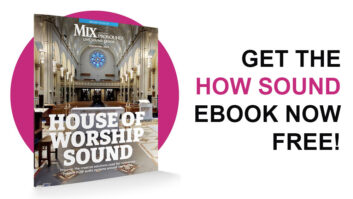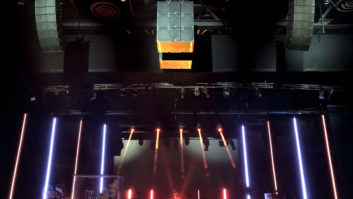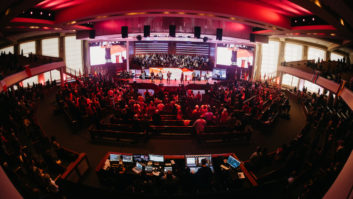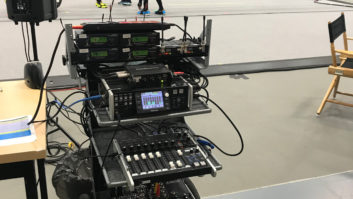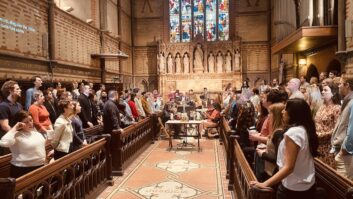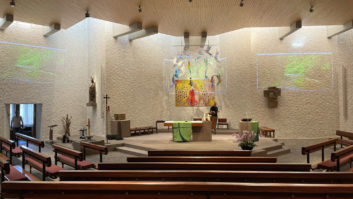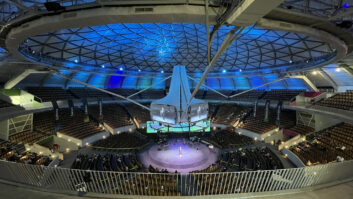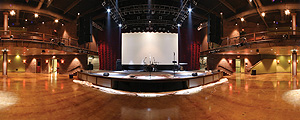
Southeast Christian Church’s The Block features a d&b audioteknik C Series P.A.
It should not be news to Mix readers that full-sized line arrays and digital consoles are part-and-parcel of house of worship (HOW) installations. But what may come as a surprise is the fact that these installs are not just reinforcing spoken-word audio. These venues are also becoming multipurpose facilities, where the congregation meets to enjoy live music performances, enjoy recreation opportunities, have a cup of Joe and much more. For system installers, these expanded services add a new dimension to their specs: While spoken word is still of prime importance, the audio gear that is provided must also offer a thumping low end that concertgoers expect. Mix examined a couple of recent installs to see just how high-end these spaces are becoming. [Eds. Note: Editorial for Harvest Bible Chapel was provided by sister publication Sound & Video Contractor and written by Dan Daley.]
SOUTHEAST CHRISTIAN CHURCH, LOUISVILLE, KY.
Mirroring a trend in the market, this church added a new 1,200-seat room (The Block) that is youth-oriented and multimedia-intensive. Here, teens can climb rock walls, play videogames, surf the Net and experience concerts. For the audio installation, the church turned to Mankin Media Systems (Franklin, Tenn.), a systems integrator. Tackling the concert-friendly space, Southeast Christian Church envisioned a House of Blues-style setup: a three-sided balcony and small stage.
“It’s pretty small; people get packed in,” says Stephen Roberts of MMS. Immediately, this threw up some acoustical red flags for the company, as spoken word was still high up on the needs, but the owners also wanted the venue to be used during the week, when they would bring in bands and host events.

Over at The Block’s monitor world sits a Digidesign MixRack for stage monitors.
“The technical challenges were steep from the outset as the first MMS Dream Session revealed Southeast’s desire for functionality that would cost more than twice their initial budget,” Roberts says. “Through our 3D [Dream, Design, Deploy] process, we designed a system that is to broadcast standards for audio, video and lighting.”
To start, the team entered the room’s dimensions and data into [Renkus-Heinz’s] EASE to find out which P.A. would be best suited in the space. “We took the room, put it into computer models and said, based on that, here’s some speaker systems that will work,” Roberts recalls. “The client already had previous experiences with a few of those and selected d&b audioteknik [c Series], and they said let’s hear this one to make sure it will work for the space. So we brought them down to Nashville and they listened to it and loved it.” Twelve months later, the system—powered by d&b amps—was installed.
“With the advent of line array technology, a lot of churches are saying, ‘We’re moving to a more contemporary, louder volume. Can we put in a line array?’ Then at The Block, they want to see the technology—speakers right there where everybody sees them. That’s not necessarily a bad thing. It’s meant to be the club feel with big speakers.

The Block’s front-of-house rig includes a Digidesign VENUE.
“That’s the second half of the equation,” he continues. “Once you choose your speaker, you model in the space where you’re going to hang it, and visually we can look at the space and say these are going to be problem areas just based on experience, but then the model complements that: ‘Okay, you have a reverb time of 3 seconds currently because it’s all concrete brick.’ So we go in and place acoustics in the model to break down that reverb time to something acceptable for speech. We placed lots of acoustic [treatments] on walls, and with this project, we built a five-year plan of technology implementation, and part of that plan was adding acoustics; they didn’t have enough money up front to completely do all the treatment they wanted. But over the next five years, they’ll purchase acoustics for this additional area.”
To outfit the rest of the space, Roberts chose a Digidesign VENUE for front of house. “Audio is crucial to the system, and as such, the client—after demoing and working with different consoles—selected the Digidesign VENUE as the best trade-off between a great-sounding console and easy volunteer operability,” Roberts says. “To fit the budget for the building, we value-engineered the system to work with the Digidesign MixRack to save money while still providing all the functionality the church needed. Backstage at monitor world, there is another Digidesign MixRack for stage monitors and a patchbay to route audio signals to all rooms in the building, as well as stage inputs.”
Roberts says that the audio from the mics to the console stays analog because it is inherently reliable and cost-effective. The A/D conversion happens at the console and stays digital. The drive lines from the console to the amps are AES digital lines. “We believe in retaining high-quality signals while using the flexibility of digital audio, which is why there is only one conversion point,” Roberts says. Rounding out The Block’s feature set are Sennheiser G2 wireless ears, Shure UHF-R wireless systems, a full complement of lighting and video gear, and more.
While many system installs are fully finished before staff training begins, the technical crew at the church was able to use the gear at their old space before moving to the new venue. “This allowed them to not be shell-shocked when trying to learn everything between two Sundays,” Roberts explains. “The Southeast team is very tech-savvy and was able to pick up the basics quickly, while still learning and trying out some of the more advanced features of their equipment with each new event.”
The project also paid off for Mankin Media Systems, as the company won three of last year’s Solomon Awards (Best Tech Consultant and/or Contractor; Best Overall Church Technology Project; and Best Design, Implementation and Operation of an Audio, Video and Lighting System) at the 4th Annual Worship Facilities Conference and Expo.

The 41,000-square-foot addition to Harvest Bible Chapel features a Renkus-Heinz ST Series P.A.
HARVEST BIBLE CHAPEL, WEST OLIVE, MICH.
Located in the suburbs of Grand Rapids, this parish recently completed a 41,000-plus-square-foot addition to the church’s existing facility, adding more seating for its congregation of more than 1,000 members, a café lounge, a tiered 120-seat lecture room and a choir rehearsal/recording studio that can hold 80 people. It also gave the church the kind of space it needed to support an increasingly contemporary, music-based ministry.
Parkway Electric & Communications was a logical choice to do the A/V systems integration—Parkway project manager Steve Driesenga is also a member of the congregation, which might have contributed to its decision to green-light some pretty advanced technology. That included a Whirlwind digital Ethernet snake from the stage to the front-of-house position and Ethernet cabling from there over to the amp rack and then back to the stage for the Aviom digital in-ear monitoring system.
“The in-ear monitors allow each musician to control his or her own mix, which is very important to a ministry that emphasizes music so heavily, and using the snake let us reduce cabling by a significant amount, as well as simplified the installation and prepared the facility for future expansion,” explains Jeff VandeHoef, project engineer for Parkway. “We’re seeing things that have become more common in 5,000-seat churches now becoming part of the system design for 700- to 1,000-seat churches,” Driesenga says.
Microphone inputs can be plugged into floor pockets around the stage that are tied directly into the digital snake in a Middle Atlantic MPR-8 power raceway. The signals come up on the new Yamaha M7CL FOH mixer, where three Ethernet cards convert the signal to data that is fed to the monitor system (via Axiom cards also in the console) and to the Lowell and Raxxess Metalsmiths amp racks and back to the P.A. The P.A. is self-powered, using Renkus-Heinz ST Series loudspeakers. Four loudspeakers—two ST6/64 and two ST4/44 models—are flown across the stage, buttressed by four Renkus-Heinz BPS15-2K subs placed two per side and built into the base of the stage. Front-fill for the first few rows is done using six JBL Control 28 loudspeakers and seven Atlas FAP42T ceiling loudspeakers with 55ms delays that fill in the back of the hall, powered by Crown CDi and XTi series amplifiers. The P.A. system is optimized for music and speech intelligibility, using a dbx 231 equalizer and the Yamaha M7’s onboard DSP and its memory-recall feature, which lets the mixer flip between optimized settings for speech and music.
As for the Yamaha board, Driesenga says, “Church volunteers adapted well to the digital board and ultimately found themselves relying heavily on many of the new digital features—such as saving presets, scenes and entire mixes—which constitute additional time and effort savings.”
Acoustics By Design, an independent consulting company, was brought in by the general contractor, Dan Vos Construction (both located in Grand Rapids), to offer acoustical engineering and A/V consultation for the project. ABD worked directly with the church to ensure the space was optimized for worship, says Kenric Van Wyk, president of ABD. He says he used the EASE Address software modeling of the space to predict its acoustical fingerprint and to determine loudspeaker selection and location. According to Van Wyk, the need was to redirect the acoustical energy more evenly throughout the room, to overcome node buildups caused by sonic reflections. The solution came in the form of custom-made side-wall reflectors made from drywall and cut into an elliptical shape about eight feet wide. “These reflective diffusers deliver the sound evenly throughout the sanctuary,” he says.
Other innovations include a 10×10-foot clear plastic drum kit enclosure for isolation and ButtKicker pads for both the bass player and the drummer, who share outputs from the ButtKicker’s amplifier.
All the while, the design had to be flexible and economical. Driesenga notes the dramatic lessening of cable runs thanks to the digital snake, the Ethernet signal distribution and the self-powered P.A. loudspeakers. The digital patching capability of the console and the snake also make for a more efficient signal routing system. “We’re not seeing investment in those types of equipment happening yet on a regular basis in churches,” he says. “But the operational flexibility they offer is certainly worth their cost because features like preset scenes can let the space be used by a wider variety of performances.”
Driesenga acknowledges the steeper learning curve that a digital console presents, noting that most volunteer sound techs at churches have yet to master digital mix consoles. At Harvest Bible, three volunteers underwent training from Parkway to learn the Yamaha M7. “But once they realize what they can do with these systems, I think their reluctance will begin to fade away,” Driesenga says.
Sarah Benzuly is
Mix
’s managing editor.
